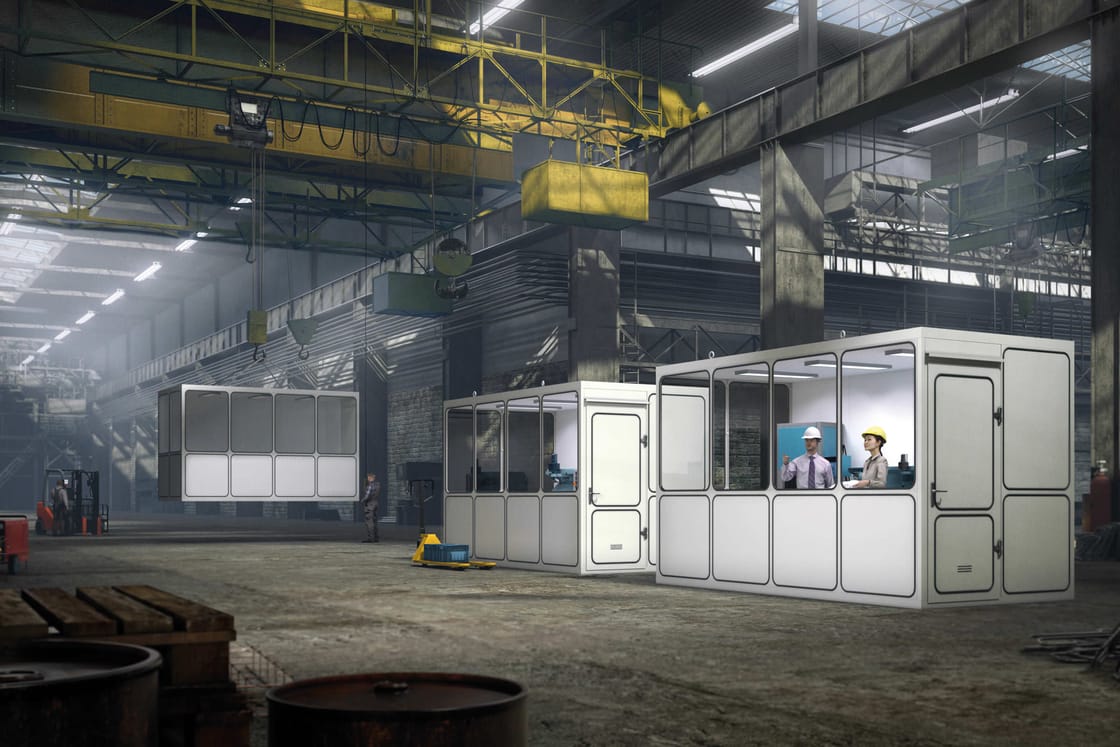Spaces in factory planning
Rooms offer protection by separating them from disturbing or harmful environmental influences, and they take on the task of concentrating a wide variety of functions in a defined location and making them usable. This could be an abstract definition. One thing is certain: rooms are an important part of any factory design. And this in turn depends on dynamic factors or drivers such as market dynamics, technological developments, legal requirements and, last but not least, changing employee needs.
The main objective of this planning is to ensure a technically flawless and economically efficient production process with optimal working conditions for the people working in the factory under changing conditions and sub-targets. In summary, this planning pursues four main objectives: ensuring a favorable, i.e. smooth, trouble-free and flexible production and manufacturing flow, realizing ergonomically favorable, low-fatigue, safe and motivating working conditions, optimal utilization of space and area, and flexibility of buildings, plants and equipment.
Factory Planning – Everything in Flux
Anyone who imagines a factory to be something static is mistaken. The modern factory comprises highly productive assembly and production facilities, which are characterized by a high degree of complexity and which are, in fact, subject to constant optimization and restructuring measures. Experts estimate that factories are completely reorganized every year and a half on average. This is the only way to maintain competitiveness and profitability.
Modern factory planning sets the course here and ensures the necessary flexibility. In doing so, it avoids rigid, invariant structures or structures that can only be changed with considerable effort and disruptive potential. This is demonstrated by a factory layout that can adapt to all necessary changes, such as the use of new machines or the redesign of production lines, and reduces change-related downtime. Thus, the routes for conveyors and people are calculated in the same way as intermediate storage for tools and material. Both adapt precisely to any necessary changes.
Lean Management
The goal of factory planning, which is now mostly oriented toward the paradigm of lean management, calls for eliminating waste of time and other resources or minimizing it as much as at all possible. Sophisticated MTM (Methods-Time-Measurement) analyses are used to analyze workflows down to the second, set planned and target times, and vary them as required.
A continuous improvement process (CIP), which ideally also involves the employees concerned, helps to identify further potential for improvement, reduce redundancies and identify and eliminate bottlenecks – also in a forward-looking manner.
The principles of lean management or lean production are not without controversy. However, the goal of organizing factories as efficiently as possible will also make sense where production is more individualized and work processes can be correspondingly less condensed.
Efficiency from the computer
The modern factory is now mostly created on the computer. Before the first employee has entered the building, his colleagues have already done their work in the virtual factory. In the process, all conceivable arrangement variants of warehouses, machines, plants and rooms are run through until an optimum oriented to the undisturbed flow results.
Sophisticated 2D and 3D software allows planning of the future factory to the millimeter and, moreover, unlimited combination and variation of its elements in two or three dimensions, including consideration of safety standards, connections or interfering edges. Manufacturers of machines, plants and room systems provide the data required for this purpose. So nothing is left to chance.
Human factor
No matter how rationally and efficiently production processes can be organized, the needs of the employees performing or supervising them must always be taken into account. These are already addressed in part by workplace ordinances and the like. However, other aspects, such as feel-good factors or motivators, must also be appreciated, even if psychological factors are not always easy and clear to evaluate.
Progressive factory planning, which always has the whole picture in mind, will therefore include both the ergonomic design of the workplaces themselves and the associated ecosystem with rest and retreat options, and will look for positive incentives that emanate, for example, from an appealing design and/or color scheme.
Modular all-rounder
In the modern factory, rooms are not an end in themselves, but important components of a functionally arranged whole. Prefabricated modular or mobile room systems also address the need for flexibility by and insofar as they can be individually sized and equipped and quickly made available. Another requirement relates to the ease with which forklift trucks or overhead cranes can be used, which largely eliminates the need for time-consuming dismantling and reassembly and their disruptive effects.
The possible applications of such room systems are almost unlimited and range from recreation and meeting rooms, sanitary facilities and control stands to flexible enclosures for machinery and equipment or the protection of sensitive or particularly valuable materials or tools. Made of high quality, they maintain their value for many years and thus contribute to flexible factory organization without significant wear and tear.
For deployment planning, CAD and ERP software as well as suitable interfaces are available from the manufacturer, with which 3D visualization is also readily possible.
